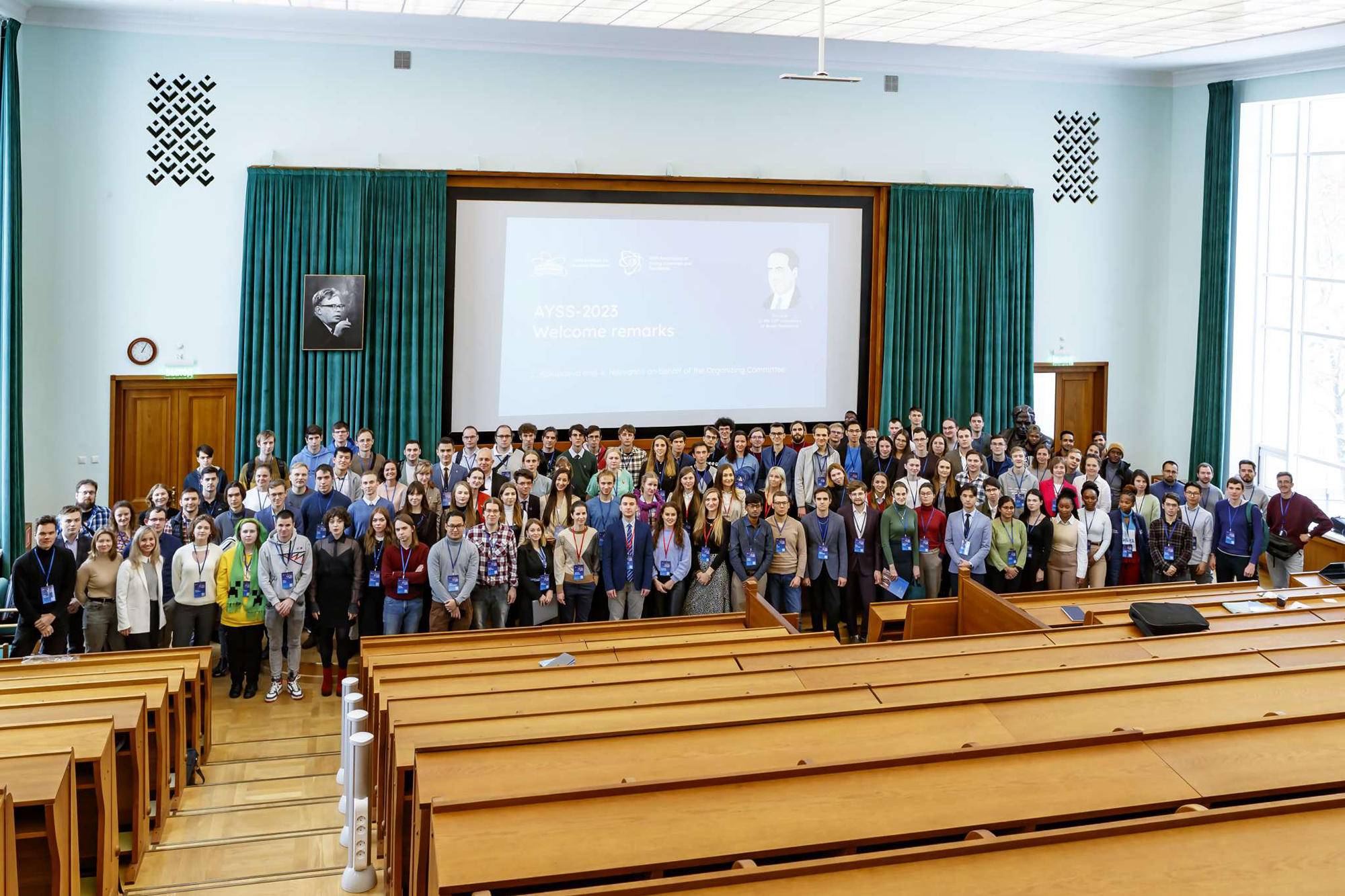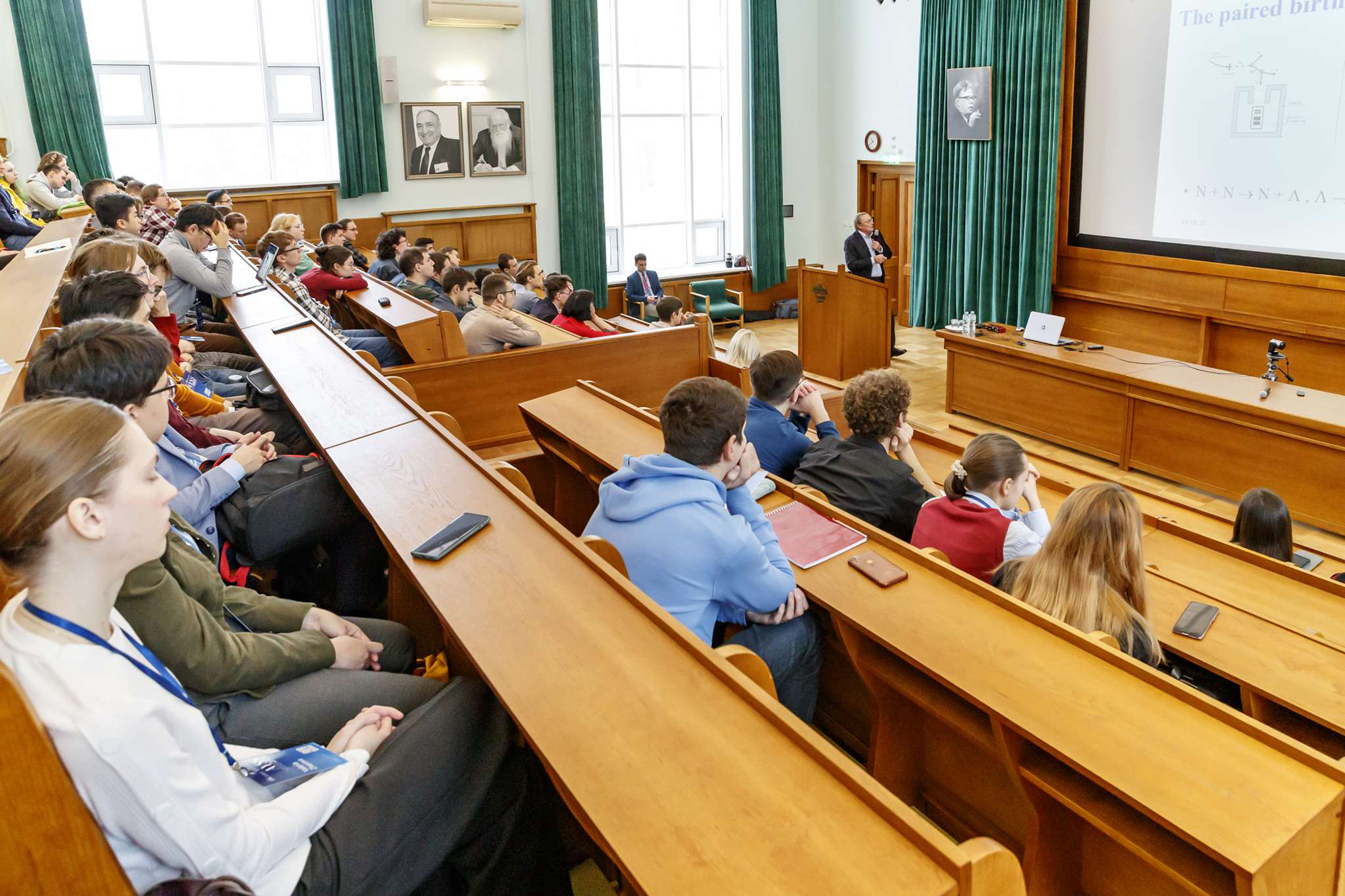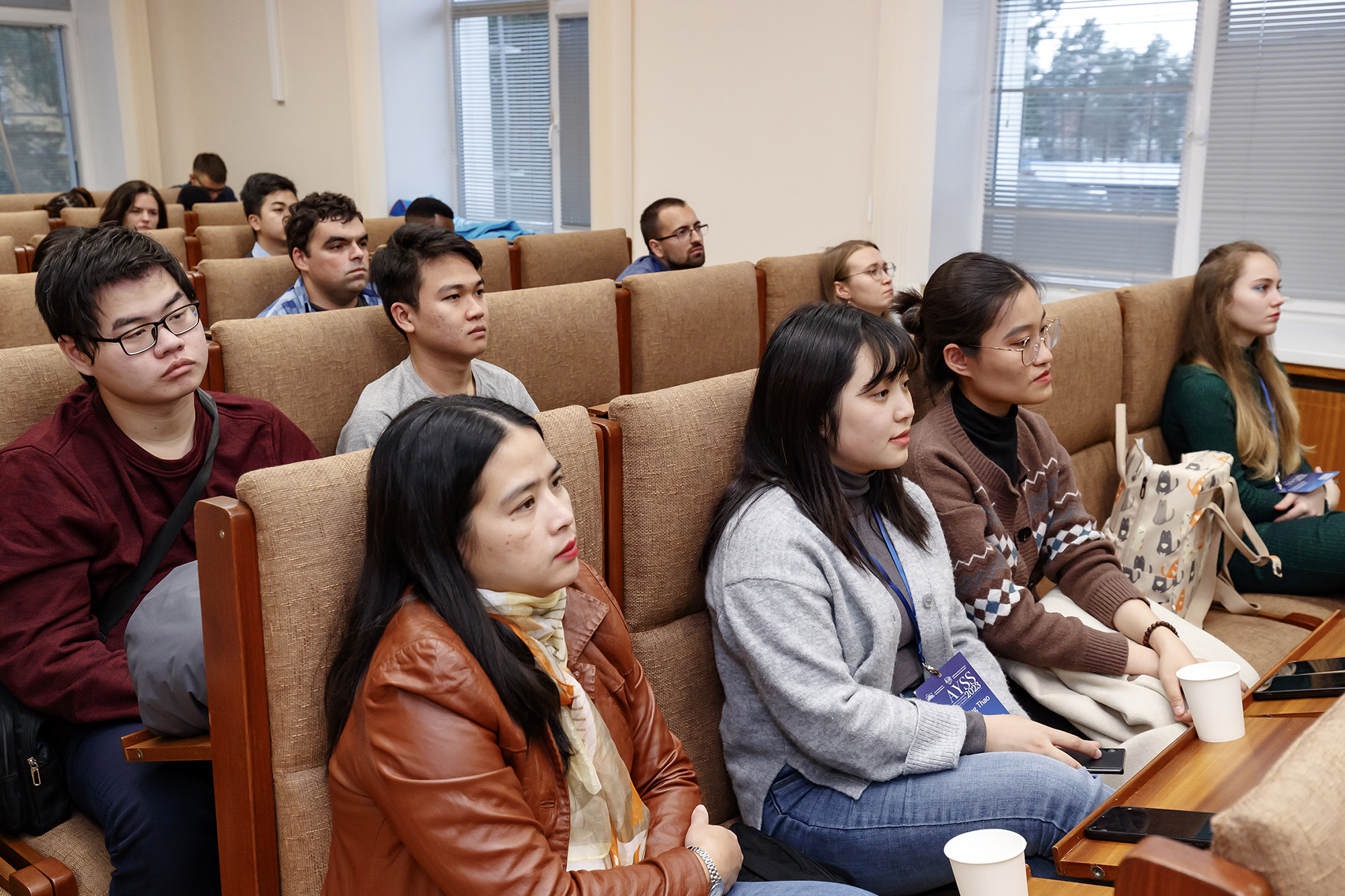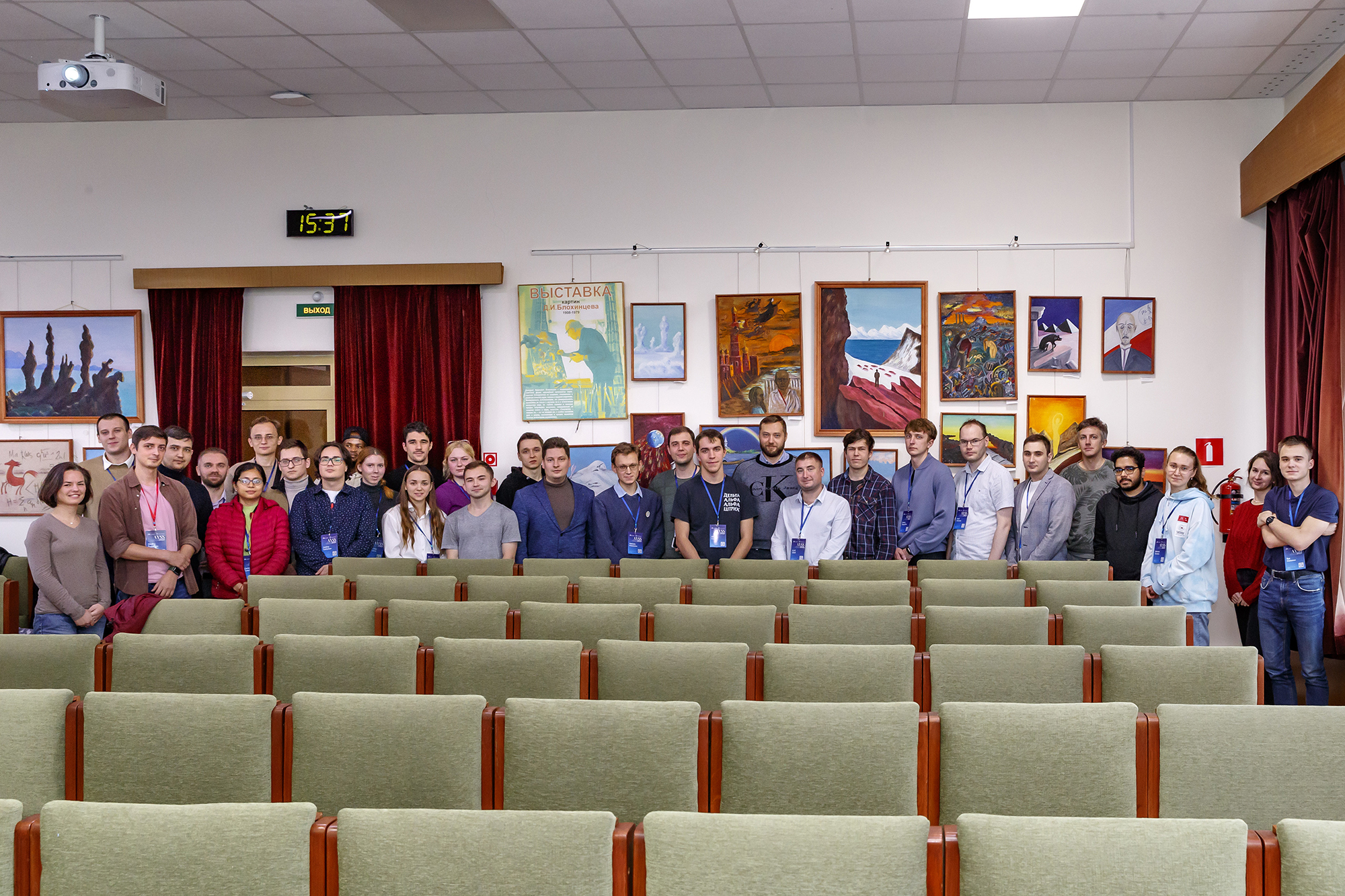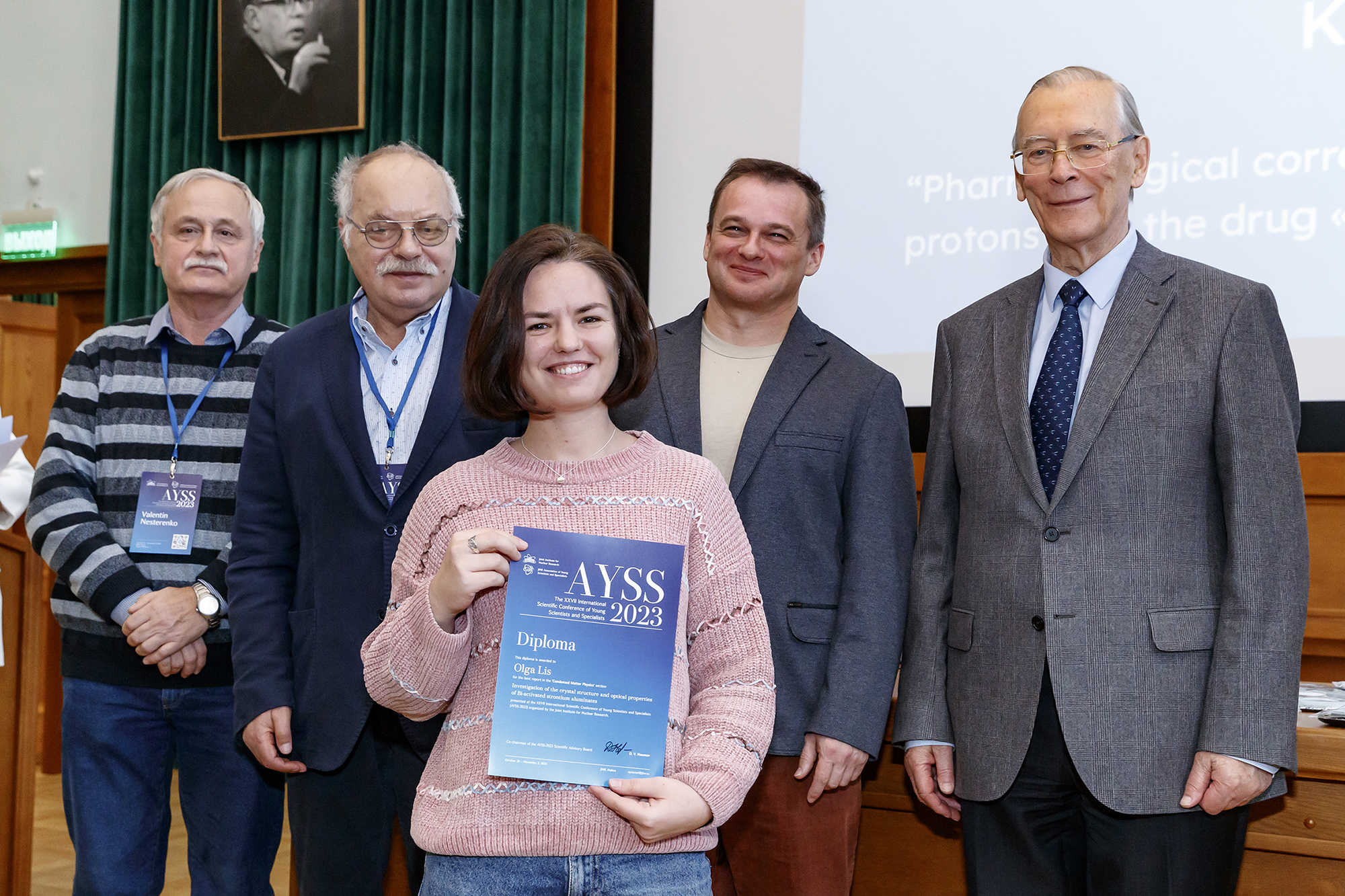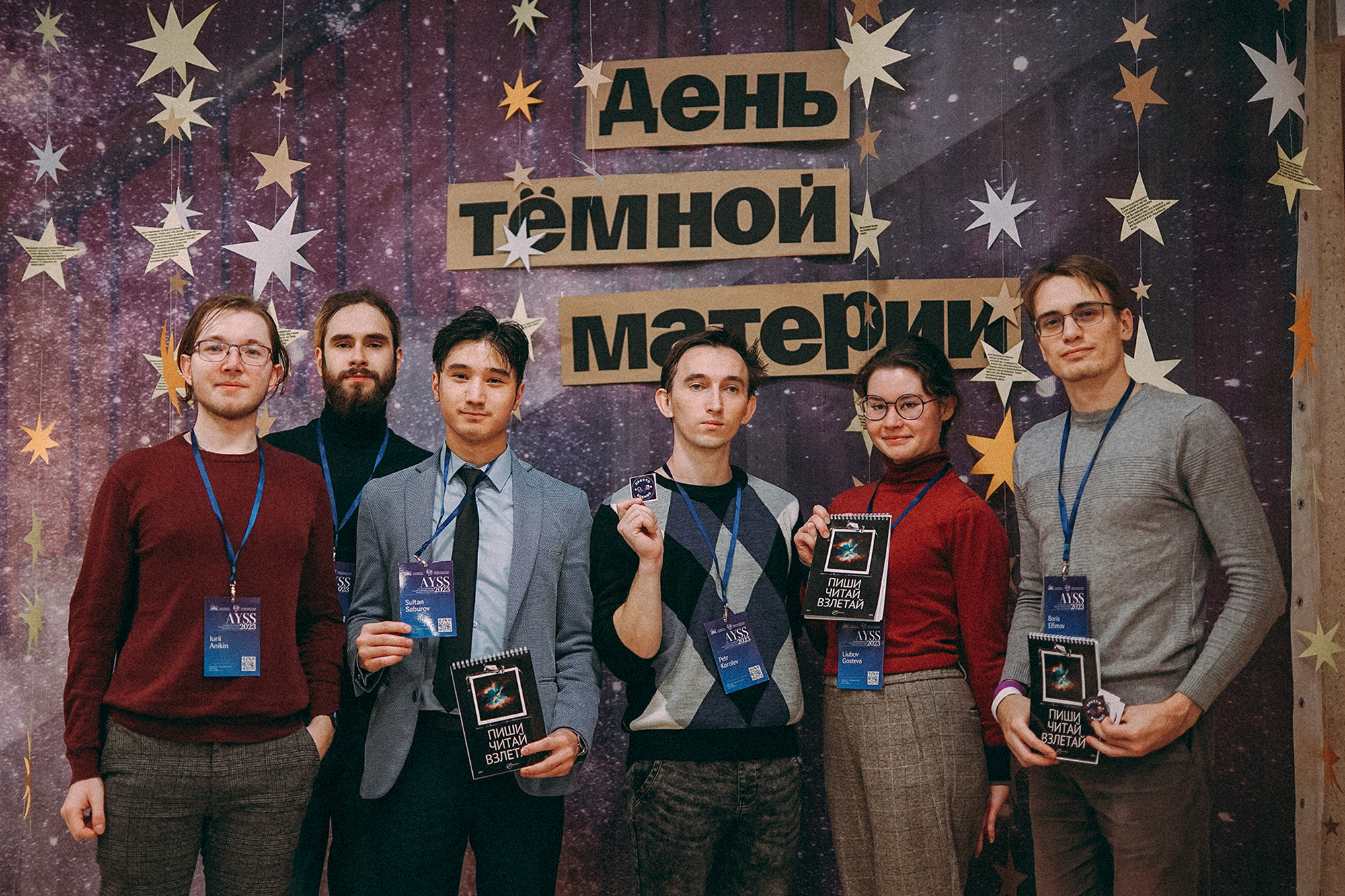AYSS-2023 Conference: new formats and records
Conferences, 13 November 2023
3 November 2023 marked the final day of the 27th International Conference of Young Scientists and Specialists, AYSS-2023. It was a long-week event that brought together young scientists from many parts of the world in Dubna. Members of the AYSS-2023 Organizing Committee spoke about the results, new features, and highlights of the event.
The scientific event hosted by the Joint Institute for Nuclear Research each autumn gives young employees the opportunity to talk about the results of their activities and attracts a large number of guests from all over the world to the city on the banks of the Volga River. The AYSS Conference is organized annually by the Association of Young Scientists and Specialists of our Institute (AYSS). This year, the event was hosted by the Dzhelepov Laboratory of Nuclear Problems (DLNP), AYSS-2023 co-organizer, and the Bogoliubov Laboratory of Theoretical Physics (BLTP). The conference was dedicated to a memorable date, the 110th anniversary of the birth of the outstanding physicist Bruno M. Pontecorvo. The plenary reports were devoted to the influence and contribution of Bruno Pontecorvo to the formation and development of modern neutrino physics. The programme of the thematic conference was formed by the AYSS-2023 Scientific Advisory Board under the chairship of JINR Director Grigory Trubnikov and DLNP JINR Deputy Director Dmitry Naumov.
The organizers did their best to address all the usual objectives of the conference successfully:
- to expand the scientific horizons of the participants and the interested JINR employees through review reports from leading researchers;
- to give young scientists and specialists an opportunity to improve the skills of presenting the results of their research;
- to introduce external participants to JINR, its primary facilities, experiments, and history;
- to show external participants (most often students and postgraduates) that our Institute is a wonderful place to write a diploma or dissertation, start their scientific career, and focus on their chosen topic;
- to form new work connections between young scientists from different organizations and different countries; to create conditions for the exchange of experience and information.
AYSS Chair Vladislav Rozhkov said: “This conference took a step forward in terms of making JINR visible and recognisable. A lot of attention was paid to promoting the Institute as a place for writing theses and diplomas for the participants, hopefully future JINR employees.”
For many years, AYSS has been actively cooperating with the world’s leading universities and institutes, especially in informing students, postgraduates, and young scientists about the scientific schools and conferences held at JINR. The results of this work are noticeable in the record number of people willing to participate in AYSS-2023. Young researchers showed great interest in the conference as early as during registration: the organizing committee received 308 applications for participation and 274 abstracts of reports. Members of the Scientific Advisory Board from all the laboratories of the Institute carefully and promptly reviewed all applications in a wide range of topics to select the reports that were of the greatest interest. The final programme of the event included 149 oral and 77 poster presentations by young scientists. The total number of participants in this year’s conference was 240 people. 107 of them were employees of JINR laboratories, and 133 represented 45 universities and research organizations from seven countries. This year, the entire scientific programme, including both plenary and parallel sections, was broadcast to JINR Information Centres located in different parts of the world.
Besides young scientists, specialists of JINR and Institute for Nuclear Research of the Russian Academy of Sciences spoke at the conference as well. They presented plenary lectures on the scientific heritage of Bruno Pontecorvo through the prism of the current state of the relevant fields of physics. The lecturers noted the keen interest and the sophisticated questions of the audience. Often, the question and answer time took much more than the scheduled 20 minutes. Discussions usually continued even during breaks between lectures. All of this made it hard for the plenary speakers to pick the author of the best question, who would then receive a gift from them, a hoodie with a cartoon by Mikhail Bilenky, the son of Professor Samoil Bilenky, a close friend, co-author and colleague of Bruno Pontecorvo. The second hoodie was a gift to the speaker, creating a unique connection between scientists, laboratories, cities, and even countries. The gift project was carried out with the support of the Laboratory of Nuclear Problems, the co-organizer of this year’s conference.
JINR Scientific Leader Victor Matveev noted: “What impressed me was the outstanding speakers, their interesting, informative lectures on the status of science, and the thoughtful questions by the participants. It’s nice to know this is the generation that will come after us. Young scientists are ready to make discoveries and are eager to work, so it is very important for us to help them enter real science as soon as possible.”
An important point of the event was the first announcement of the key elements of the new JINR Communication Strategy in a special report by International Cooperation Advisor to the Institute’s Director Irek Suleymanov. The goals and tasks of this strategy are also consistent with the AYSS-2023 Conference itself, aimed, among other things, at developing JINR’s scientific cooperation with young researchers around the world, colleagues in joint projects, and potential collaborators to exchange information on relevant research.
Every afternoon, parallel sections were held for young scientists to present reports in nine topics meeting the scientific spectrum of JINR interests: theoretical physics, mathematical modelling and computational physics, high energy physics, particle accelerators and nuclear reactors, experimental nuclear physics, information technology, condensed matter physics, applied research, and life sciences. The jury consisted of the Institute’s experts and was tasked with selecting the best reports in each thematic section. Like the plenary speakers, they were facing a difficult choice, mainly complicated by the high level of reports.
Later, the winners were awarded commemorative prizes by JINR Scientific Leader Victor Matveev, Assistant Director of the Institute for the Development of Biomedical Projects Grigory Shirkov, Scientific Advisory Board Co-Chair, DLNP JINR Deputy Director Dmitry Naumov, and a member of the Scientific Advisory Board Valentin Nesterenko.
“The conference brilliantly combined elements of a scientific forum and an educational school. I especially appreciate the latter, as it is highly important for young scientists seeking new knowledge. The participants demonstrated their full potential, presenting their research at a highly professional level. It was evident that everyone enjoyed the conference, and the scientific topics under discussion aroused great interest. The conversations were fruitful, and new professional contacts were formed,” Co-Chair of the Scientific Advisory Board Dmitry Naumov commented.
In addition, a poster presentation session took place, coupled with a welcome buffet for the guests. 77 posters were presented at the JINR International Conference Centre, and an expert jury consisting of the Scientific Advisory Board members and JINR employees selected the best poster presentation. An interesting new rule was introduced for the participants to evaluate the posters as well. According to the results of the voting, the “audience award poster” was selected. This additionally stimulated the participants to communicate with each other and develop their scientific review skills, which will certainly be useful to them in the future.
While the Scientific Advisory Board was responsible for the scientific programme, the Organizing Committee ensured the efficiency of the event. The Organizing Committee consists of 14 people, 12 of whom are AYSS members from all laboratories and departments of the Institute. Liudmila Kolupaeva (DLNP) and Alexander Nezvanov (FLNP) co-chaired this year’s Organizing Committee.
In addition to fulfilling the tasks set by the Scientific Advisory Board and the JINR Directorate, the Organizing Committee thought out an extensive list of evening events of the social programme with a focus on science and culture. The conference participants had the opportunity to get acquainted with a significant part of JINR’s rich social infrastructure and to feel the international creative spirit of the Institute.
For example, on Sunday, 29 October, upon arrival of the majority of participants in Dubna, a young gifted pianist from Armenia Aida Avanesyan gave a concert at the JINR Scientists’ Club. Young scientists were invited to the concert as well. The exceptional performance inspired the audience, setting a creative tone for the upcoming conference.
Every working day started at 8:30 AM with a special session hosted by participants from different countries. The main goal was to tell colleagues about their native country (Cuba, South Africa, India, Serbia, or Vietnam) and the status of science and the education system in it. The organizers appreciated the creative approach to the presentations and the support of compatriots among participants and the JINR employees.
On Tuesday, the JINR Blokhintsev Universal Public Library celebrated the International Dark Matter Day with an open-air scientific and entertainment quest with both serious and fun tasks for the citizens and the conference participants. The participants of the conference had an excellent opportunity to get acquainted with the Institute District of Dubna. On the same evening, a VBLHEP leading researcher Sergey Merts gave a lecture in complete darkness on interesting and frightening facts from the world of particle and nuclear physics. The day finished with dramatic stories from the lives of great scientists and ordinary people at the beginning of the last century.
On Wednesday, the Mir Cultural Centre hosted a screening of the Bruno Pontecorvo Documentary directed by Ella Vlasova. The film tells about the life of one of the greatest physicists of Italy and the USSR and the time he devoted to work in Dubna. The audience saw interviews with many of Bruno Pontecorvo’s contemporaries, family members, and friends, along with archival footage from the DLNP JINR site, which they had left a few minutes earlier after the last reports of young scientists in thematic sections. The Organizing Committee prepared English subtitles in advance, so after the film, a long discussion in different languages took place in front if the Cultural Centre.
A dinner was held on Thursday as part of the conference to sum up interim results in an informal setting. The relaxed atmosphere was facilitated by the performance of the People on the Moon Rock Band, which includes JINR employees. BLTP Scientific Secretary Alexander Andreev commented on his performance: “As the Scientific Secretary of the Laboratory of Theoretical Physics at JINR, I am glad we got to host the conference. This is a significant event, and it is expanding each year, with the number of participants and educational and scientific organizations they represent increasing. And as a member of People on the Moon, I thank the organizers for giving our band the opportunity to perform at the conference. It was the first important trial run for us with the updated lineup, and the audience was very supportive.”
On Friday, after the end of the conference, participants were invited to get introduced to the JINR research facilities: the Multifunctional Information and Computing Complex of the Laboratory of Information Technologies (MLIT), along with the Medical and Technical Complex Based on the Phasotron, the assembly complex of equipment for the Baikal-GVD Experiment, the remote control centre of the NOvA Experiment, and the Dark Room with compensation of the Earth’s magnetic field at the Laboratory of Nuclear Problems. Late in the evening, on the Volga Embankment, the remaining participants got acquainted with amateur astronomy. Together with a DLNP JINR employee Alexey Chetverikov they had the chance to observe the planets, the Moon, take photos of the nebula, and learn the details of the operation of specialised equipment and programs.
AYSS-2023 Organizing Committee notes: “Such a success of the event would not have been possible without the huge contribution of the Scientific Advisory Board and the DLNP JINR as the co-organizer of the conference. Many JINR employees were involved as moderators of sections and juries, assisting the Organizing Committee in solving issues. DLNP, VBLHEP, FLNP, FLNR, and LRB provided great assistance the external participants. MLIT helped with sound equipment and broadcasting of scientific sections of the conference to JINR Information Centres. BLTP and DLNP provided convenient venues for the event. And the staff of the Institute’s Departments, and the UC in particular, ensured uninterrupted document flow and paperwork for a large number of external participants, whose admission was a non-trivial task. DLNP Scientific Communications Group, the Communications and Information Support Department, and the UC Social Communications Group provided us with comprehensive information support. And although the conference is traditionally associated with AYSS, the entire Institute worked as a single well-coordinated mechanism. We are grateful for all the help received. This is a truly great scientific achievement, and we want to share the joy of success with all the colleagues involved.”
